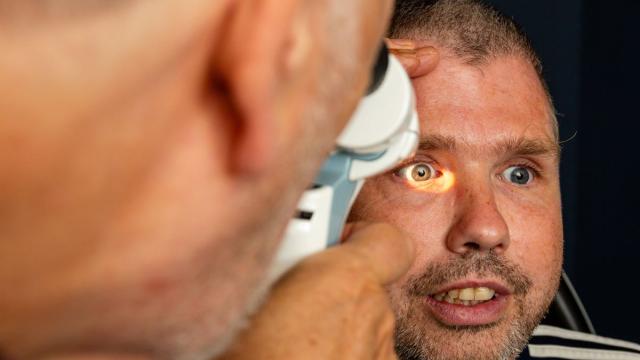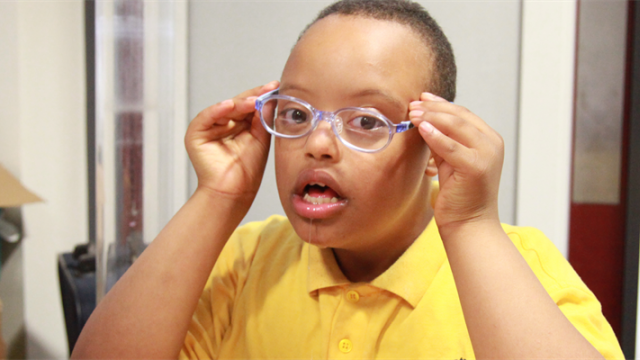What happens at an eye test
There are many different parts to an eye test, and all should ideally be carried out but not necessarily in the order below. Some optometry services have other staff who carry out some of the tests instead of the optometrist.
Step 1: Checking the health of the eye
They will do an eye health check to look for eye diseases or damage inside and outside the eye. An eye health check is made up of a lot of different tests and will include a torch light being shone from very close into the eye, so the optometrists can get a clear look at the back of the eye. The optometrist may need to turn out the lights to get the best view.
The optometrist may also do an examination to check the pressure within the eye (one of the tests for glaucoma), especially in an older person. This examination may involve air being puffed into the eye.
Many optometrists take a photograph of the inside of the eye. This involves the person keeping very still and looking straight ahead into a special camera that flashes a very bright light in the eyes.
If any of these things may upset the person having their eyes examined, it is important to let the optometrist know in advance.
Step 2: Eye drops
Eye drops may need to be put in the person’s eye to widen the pupil and stop it reacting to light. This is done to get a better look at the inside of the eye and sometimes helps in finding the correct glasses prescription. The dilating eye drops sting a little and take 15 to 20 minutes to work. You may need to go back and wait in reception while the eye drops start to work. Eye drops may take a couple of hours to wear off and during that time people can have problems with bright light and moving around, as vision is usually a bit blurred.
You can ask the optometrist to put in anaesthetic eye drops first, so that the dilating eye drops do not sting.
Step 3: Checking vision
An evaluation of eye movement control (a ‘binocular vision check’) will take place to assess how the two eyes work together. The ability to judge distance and depth (3D vision), may also be measured. An examination to check the pupil’s reactions to light will be carried out.
The optometrist will also examine the person’s level of vision for both distance and near tasks. They will also measure the eyes for shortsightedness, longsightedness, astigmatism and/or poor near focusing. This will determine if there is a need for glasses or contact lenses for near vision, distance vision or both.
A visual fields test to assess ‘all round vision’ will take place. It is important that the optometrist examines a person’s visual field, which is the extent to which a person can see around them without moving either their eyes or head. This test should establish whether a person has full all-round (peripheral) vision, loss on one side or the other, has lost their central vision, or has tunnel or ‘patchy’ vision. This test can be done by asking the person to look at a central dot of light in a machine and then count the dots of light that appear around it. Alternatively, this can be assessed by holding objects up at different positions in the person’s visual fields.
The optometrist will examine the level of vision (‘visual acuity’). Testing visual acuity can be enjoyable and you can practice this part of the test at home so that the person is prepared. The following tests may be used to check the level of vision.
Having an eye test (easy read)
Advice on having an eye test for people with learning disabilities.
This is an easy read document
Making eye tests easy
How to use eye drops (easy read)
This is an easy read document
Letter charts and tests
Snellen chart
The Snellen chart is commonly seen in GP surgeries, optometrists and hospital eye clinics, and involves reading the letters down the chart, starting with the largest one at the top.
There are other charts for people who cannot identify letters but can match the letters. The optometrist holds up a booklet containing one letter, or a row of letters, on a page. The person responds by pointing to letters on a card held on their lap.

Kay Picture test
A Kay Picture test involves the optometrist presenting a single black picture or a row of pictures (like a boot, clock, duck) and the person responds by naming or pointing at a picture on a matching card. Alternatively, the person might sign in Makaton to identify the picture to the optometrist. Different sized pictures are held up by the optometrist to establish the limit of a person’s vision.
Any eye care professionals who have signed up to our optometry database can purchase the Kay Pictures vision test books at half price.

Cardiff Acuity Test
The Cardiff Acuity Test was originally devised for young children, but an adult version is now available. It uses the ‘preferential looking’ principle. The person being examined does not need to name or match but simply looks at a picture either at the top or the bottom of a card. The optometrist holds the card at eye level and watches for the person’s eye movements towards the picture.
All of these tests may also be presented using a projector screen or tablet. The optometrist may also use trial frames to help them decide what lenses would help the person see best. They may place a trial frame on the person’s face. This can be a strange experience and people may find it uncomfortable.
Alternatively, the optometrist may simply hold a lens up to the person to look through it.
The optometrist will use another torch to measure which lens might make the person’s vision clearer. They may check this by asking if the lens makes things better or worse. Many people (of all levels of ability) find it hard to answer, so you may want to practice before the appointment and use phrases such as ‘nearer’ or ‘far away’ until you are clear that a consistent response is being given.
The different parts of the eye test may not all be accessible to all people with learning disabilities. Sometimes the optometrist can adapt a test to make it suitable for a person with learning disabilities. However, even if an eye test is not fully completed, this is always preferable to no eye test at all. With consistency and good support, the person can be supported to be more prepared for their next eye test and have a more successful outcome.
Bradford Visual Function Box
Traditional eye tests can be challenging for people with learning disabilities. We've developed the Bradford Visual Function Box to tackle the problem and make sure all people with learning disabilities can have an eye test. This innovative approach means you don't need to communicate to have your eyes tested. Everyone can have an eye test – you don’t need to be able to read or speak.
Find out more about the Bradford Visual Function Box
If things go wrong
Our easy read fact sheet will tell you what should happen at your eye test and what to do if you are not happy with your eye test.
If things go wrong (easy read)
This is an easy read document





